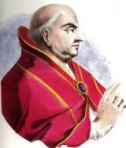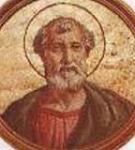Death: 655
Elected pope in 649, Pope Saint Martin I had gotten in trouble for refusing to condone silence in the face of wrong. At that time there existed a popular heresy that held that Christ didn’t have a human will, only a divine will. The emperor had issued an edict that didn’t support Monothelism (as it was known) directly, but simply commanded that no one could discuss Jesus’ will at all.
Monothelism was condemned at a council convened by Saint Martin I. In his anger, the emperor sent his soldiers to Rome to bring the pope to him. When Saint Martin I arrived in Constantinople after a long voyage he was immediately put into prison. There he spent three months in a filthy, freezing cell while he suffered from dysentery. He was not allowed to wash and given the most disgusting food. After he was condemned without being allowed to speak in his defense he was imprisoned for another three months.
From there he was exiled to the Crimea where he suffered from the famine of the land as well as the roughness of the land and its people. But hardest to take was the fact that the pope found himself friendless. His letters tell how his own church had deserted him and his friends had forgotten him. They wouldn’t even send him oil or corn to live off of.
He died two years later in exile in the year 656, a martyr who stood up for the right of the Church to establish doctrine even in the face of imperial power.







